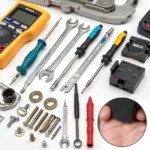Discovering a cut in your leather car seat can be disheartening. But before you panic, understand that repairing these cuts is often possible with the right approach and a bit of patience. This guide will walk you through the steps to effectively repair those unsightly cuts and restore your car’s interior.
Assessing the Damage: Know Your Enemy
The first step to any successful repair is understanding the problem. Examine the cut carefully:
- Severity: How deep is the cut? Is it a surface scratch or a deep gash?
- Location: A cut on the seat’s surface might be simpler to fix than one on a seam or a high-friction area.
- Material: Is your car seat genuine leather or synthetic leather (vinyl)? Knowing this is crucial for choosing the right repair products.
 Deep Cut in Leather Car Seat
Deep Cut in Leather Car Seat
Gather Your Repair Arsenal
Depending on the severity of the cut, you’ll need some specific tools and materials:
- Leather Cleaner: A dedicated leather cleaner will remove dirt, grime, and oils that can hinder the repair process.
- Leather Filler: For deep cuts, a leather filler is essential for creating a smooth and even surface.
- Leather Adhesive: This will bond the edges of the cut together, preventing further tearing.
- Color Matching Kit: Leather dyes and pigments help you match the repaired area to the original seat color.
- Applicator Tools: Spatulas, sponges, and brushes help apply the repair products evenly.
- Fine-grit Sandpaper: Used to smooth the filler and create a seamless finish.
- Leather Conditioner: Once the repair is complete, a conditioner will restore the leather’s softness and protect it.
Pro Tip from John Miller, Automotive Upholstery Expert: “Always choose high-quality leather repair products specifically designed for automotive use. Generic products may not be durable enough to withstand the wear and tear car seats endure.”
Repairing the Cut: A Step-by-Step Guide
Now that you’re prepared, let’s delve into the repair process:
-
Clean the Area: Thoroughly clean the damaged area and surrounding leather with a suitable leather cleaner. Ensure the surface is dry before moving on.
-
Apply Leather Filler (if needed): For deep cuts, use a leather filler to fill the gap. Apply in thin layers, allowing each layer to dry completely before applying the next.
-
Sand and Shape: Once the filler is dry, use fine-grit sandpaper to smooth the surface and match the contour of the surrounding leather.
-
Apply Leather Adhesive: Carefully apply a thin layer of leather adhesive to the edges of the cut. Press the edges together firmly and hold until the adhesive bonds.
-
Color Matching: Use the leather dye from your color matching kit to blend the repaired area with the original seat color. Apply in thin coats, allowing each coat to dry before applying the next.
-
Apply Leather Conditioner: Once the dye is dry, apply a leather conditioner to the entire seat to restore its softness and protect the repair.
Preventing Future Damage: Proactive Care Tips
- Regular Cleaning: Routine cleaning with a leather cleaner prevents dirt and grime from embedding in the leather, reducing the risk of scratches and cuts.
- Conditioning: Regular conditioning keeps the leather supple and less prone to cracking or tearing.
- Protective Covers: Consider using seat covers, especially if your car sees heavy use or you frequently transport pets or cargo.
When to Seek Professional Help
While minor cuts can be tackled with DIY methods, some situations warrant professional help:
- Extensive Damage: If the cut is very deep, involves complex stitching, or covers a large area, professional intervention is recommended.
- Airbag Deployment: Never attempt to repair a seat that has been affected by airbag deployment. Seek professional assistance to ensure safety.
FAQs: Addressing Common Queries
Q: Can I use super glue to repair a cut in my leather car seat?
A: While tempting, super glue is not recommended for leather car seat repairs. It can create a stiff, inflexible bond that is prone to cracking and may damage the surrounding leather. Opt for a dedicated leather adhesive for a more durable and flexible repair.
Q: How much does it cost to have a cut in a leather car seat professionally repaired?
A: The cost of professional repair varies depending on the severity of the damage, the type of leather, and the location. Minor repairs can range from [link to relevant page on your site], while more extensive damage might require a full seat reupholstery. For accurate pricing, it’s best to consult a reputable car upholstery specialist near you. You can find car seat repair shops near you by searching “car seat repair near me”. If you’re curious about the cost to repair a small tear, you can check out our article on “how much to repair small tear in car seat”.
Conclusion: Restoring Your Car’s Interior
Repairing a cut n leather car seat might seem daunting, but with the right approach and a bit of effort, you can achieve impressive results. By following the steps outlined in this guide and using the right products, you can restore your car’s interior and protect your investment. Remember, prevention is key to maintaining the pristine condition of your leather car seats. Regular cleaning, conditioning, and the use of protective covers can significantly minimize the risk of future damage.

